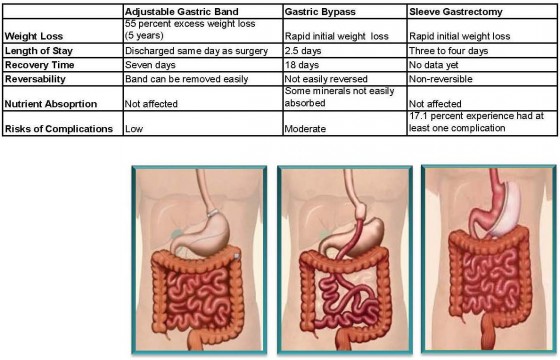
What are the Three Different Types of Weight Loss Surgeries?
With so many surgical weight loss options available today, finding the right option for you might seem overwhelming. Here is a primer on the weight loss surgeries available today to help you get the conversation started with your health care provider.
There are currently three primary weight loss (or bariatric) surgeries being performed across the United States. They are Roux-en-Y gastric bypass, adjustable gastric banding and sleeve gastrectomy. All of these surgeries have pros and cons to them, and none of them are a quick, simple fix for losing weight. With each procedure you still must follow a diet and exercise program in order to have good results – surgery is just a tool to assist in the weight loss process.
To be a candidate for weight loss surgery, you must have a BMI (body mass index) greater than 40 or a BMI greater than 35 with co-morbid conditions – meaning other medical conditions, such as heart disease, in addition to a high BMI.
Gastric Bypass
Of the three procedures, gastric bypass surgery has been performed the longest, dating back more than 20 years. The procedure involves a surgeon cutting across the top of the stomach to create a walnut-sized pouch. The surgeon then attaches the pouch to the small intestine so that food bypasses the stomach and enters directly into the small intestine. Gastric bypass is a combined procedure, which means that it restricts portion size and limits the absorption of foods, a process called “malabsorption.”
Gastric Banding
Gastric banding has been in the United States for more than 10 years and involves a surgeon placing an adjustable silicone band around the upper part of the stomach. Of the three procedures, only gastric banding is adjustable; the amount of food a person’s stomach can hold can be altered with an office visit by adjusting the tightness of the band around the stomach.
The Lap-Band® by Allergan is currently the only procedure/device with FDA approval for use in people with a BMI between 30 and 34.9. Pre-operative requirements vary depending on insurance plans and any pre-existing health conditions that may be present.
Sleeve Gastrectomy
The sleeve gastrectomy has had FDA approval for less than four years and involves a surgeon removing 80 to 85 percent of the stomach, then stapling the remaining portion of stomach together. This is a restrictive procedure that limits the amount of food you can consume.
See the table below for a brief comparison of the procedures (all statistics come from BOLD™ database / image courtesy of Lap-Band® Central). Click the image to enlarge.

 Nathan Hamman is a registered/licensed dietitian at OSF Saint Anthony Medical Center in Rockford, Illinois. He holds a Bachelor of Science degree in dietetics and nutrition from Bradley University and holds a master’s degree in exercise science and health promotion from California University of Pennsylvania. He is currently coordinator of the weight management programs at OSF Saint Anthony, as well as a clinical and outpatient dietitian.
Nathan Hamman is a registered/licensed dietitian at OSF Saint Anthony Medical Center in Rockford, Illinois. He holds a Bachelor of Science degree in dietetics and nutrition from Bradley University and holds a master’s degree in exercise science and health promotion from California University of Pennsylvania. He is currently coordinator of the weight management programs at OSF Saint Anthony, as well as a clinical and outpatient dietitian.